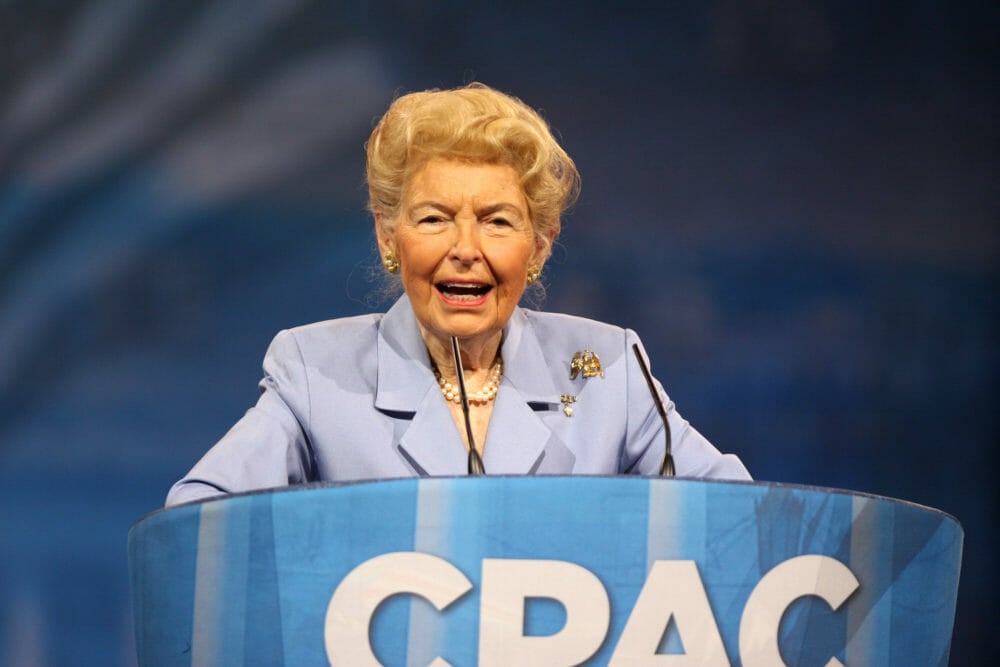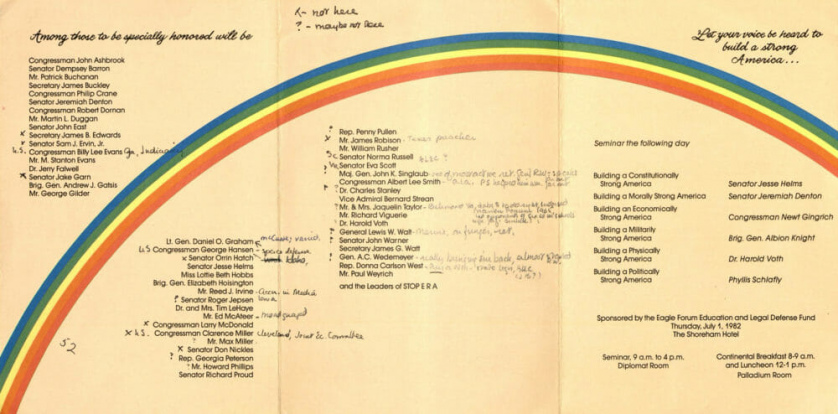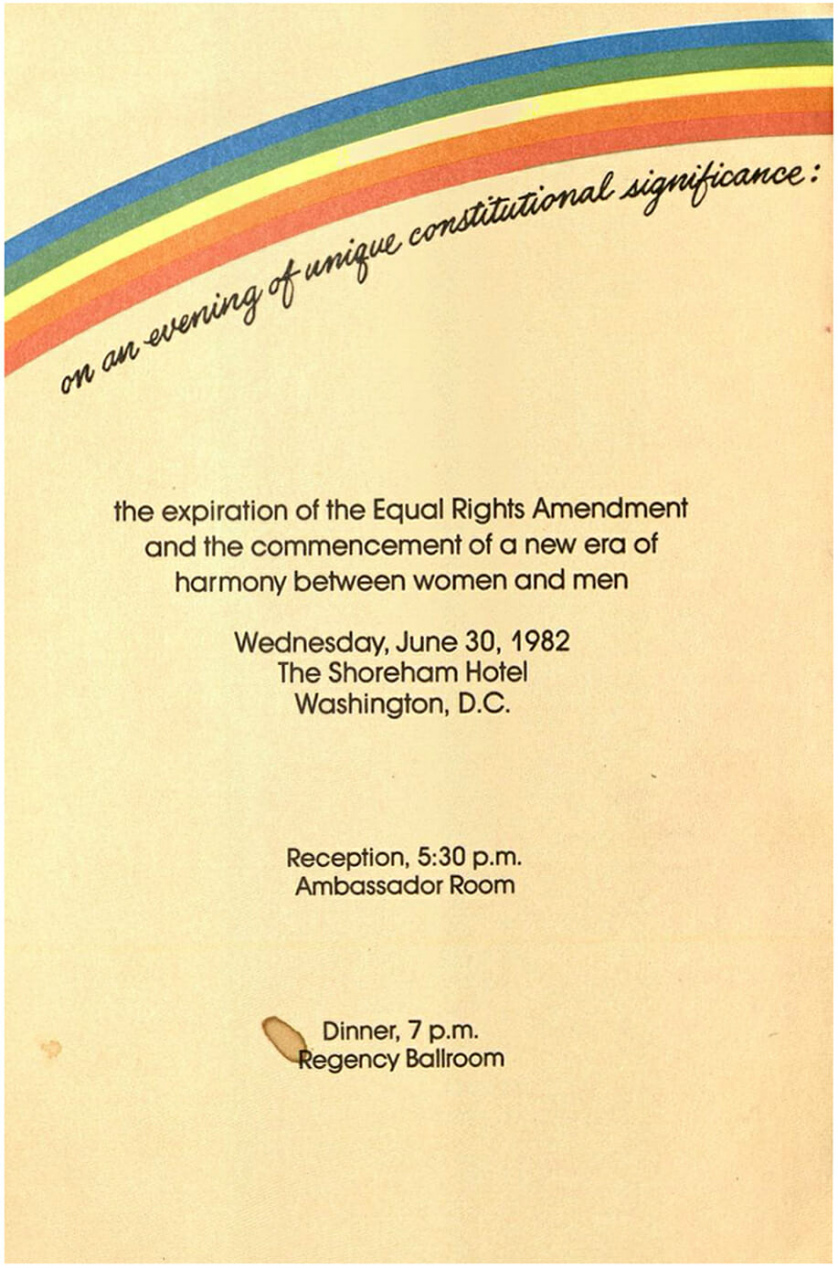The Night Phyllis Schlafly Went Over the Rainbow

Phyllis Schlafly was one of the scariest people I ever met. I suspect her personal role model was Torquemada. Certainly she was absolutely convinced of her rectitude—while being at least as ambitious as any Spanish crusader prosecuting a holy war. She nearly succeeded in derailing the National Women’s Conference in Houston in 1977, part of a global movement sponsored by the United Nations, by raising a flashy tent show in the parking lot across from the convention center. The event was a showcase of classic Schlafly agitprop: it featured ghoulish images of unborn babies, along with big STOP ERA signs and very moving pleas to protect the rights of housewives (as Schlafly’s backlash lieutenants purported them to be). The Houston papers had already printed front-page warnings that a legion of lesbians were coming to town, so she had a ready audience. It took the full force of the women’s movement, thousands of women from all over the country, to get any attention for our issues. All Phyllis Schlafly needed was a sensationalist local media and a couple of well-placed fetus posters.
Fast forward to five years later, on June 30, 1982, and Phyllis Schlafly was radiantly in the center of festivities in the grand ballroom of the Shoreham Hotel in Washington, D.C., celebrating the defeat of the Equal Rights Amendment. She took full credit for this greatest of all inquisitorial triumphs, and in the wake of her death last week, newspaper obituaries concurred as one, with one or another variation on “almost single-handedly defeated.” The ERA had been moving along to final approval, after about fifty-eight years of effort, until Schlafly and her Eagle Forum PAC discovered its potency as an issue to rally the right.
A loving entry in the guest book at the Kriegshauser funeral home in St. Louis this week admiringly summed up her legacy, which stretches far beyond the procedural defeat of the ERA, well into the court and culture wars enthusiastically prosecuted by the Trumpian right:
Wednesday, September 07, 2016
Ann Arbor, Michigan
It is frightful to envision an America denied the following benefits of her lifelong activism for traditional families and for military strength: the pro-life platform of the Republican party, the miraculous defeat of the ERA, blocking federal child care, phonics in education, anti-missile defense, fighting judicial tyranny, etc., etc. Her gifted and untiring leadership and her colossal amount of writing and speaking will never be equaled. Two of my most cherished memories are introducing Phyllis at one talk and eating a box lunch with her at another, both in Michigan.
That grand record of achievement was still a work in progress that night at the Shoreham, but as you looked around, you could definitely see it gathering force. The invitation to the Shoreham event was peach colored. The theme for the evening was “Over the Rainbow,” to signify, one supposes, the New Right’s odyssey from the Kansas interior, and the décor was a rainbow arch of multicolored balloons. How peculiar to look back and discover her son John Schlafly, a piano player, was the evening’s musical accompanist. Back in Houston, a tenacious group of feminist reporters had interviewed his mother, and Lindsy van Gelder asked her what she might do if one of her six children turned out to be gay. That would be impossible, she said. It’s since been reported that John is, in fact, gay. The gay pride movement had adopted the rainbow flag in 1978, but to judge by the Eagle Forum gala’s theme, that iconography had not broken through to the political mainstream by 1982. One can chalk that up to coincidence—together with the “friend of Dorothy” echo that attends a movement’s appropriation of the words “Over the Rainbow.”
That night at the Shoreham, the conquering heroine of the antifeminist right was gorgeously arrayed in diamond earrings, a string of pearls, and a gem-studded gold eagle brooch pinned to her blouse, oddly like an organdy pinafore. The brooch was a gift of her Eagle Warriors (a group of Eagle Forum big-money donors). She also received a gold watch from her husband Fred, and a plaque sporting a gigantic bright-red raw ruby from her followers—this time a deliberate visual echo of the bright red “Stop ERA” signs that Schlafly’s movement had made famous. At her right was Senator Jesse Helms—the former North Carolina TV station manager who would go on to be the drawling public face of the family-values right in that grim decade of cultural reaction.
Nearly 1,400 people sat at tables decorated by the Maryland Eagle Forum in the style of baby showers or birthday parties: crepe paper rainbows arching over black paper pots-of-gold with scattered jelly bean “treasure” to be carried off as prizes after dinner.

The really distinguished guests, the defenders of the Constitution, the people who had made it all possible—who indeed, had made Schlafly possible—were all, or almost all, men. Many of them were generals and naval officers. Today, it’s remembered that the newsletters published monthly by the Eagle Forum always had four pages: two on the evils of feminism, and two on the need for increased military production to battle Communism. Weapons were Phyllis Schlafly’s true love.
Apropos of this, all was not unalloyed triumph for Schlafly in the early 1980s. Ronald Reagan owed her a great deal—though, like other powerful men of the New Right, he didn’t make a practice of acknowledging his debts to powerful women. When he was elected, Schlafly stepped right up, confident that she would have the job she always wanted: something, anything, in the Defense Department. Someone in the Reagan administration told me: “She showed up, and the president said ‘Get that woman out of here!’” She was, as I say, scary. More an obsessional termagant than a useful colleague. Sad—as Trump might say today.
Still, the roll call of conservative eminences on that summer night in 1982 was truly impressive. The old right was there: the founder of the Christian Anti-Communism Crusade took a bow. The famed John Birch Society orator General Andrew J. Gatsis was also on hand—then best known for his stump warning that “we must now aim to eliminate the piecemeal efforts of the women’s lib movement to implement their humanist goals.” Schlafly herself came of age among these old right scaremongers, and sharpened her considerable organizational skills as their enthusiastic understudy.
And the then-young turks of the nascent New Right also paid admiring homage to their comrade-in-arms. Paul Weyrich, one of the New Right’s direct-mail masterminds, who also invented the baleful and influential American Legislative Exchange Council, declared that “the ERA was an early issue; it preceded abortion. I first noticed the issue in 1974 when [Schlafly] called and asked for my help.”

Dempsey Barron, the grand old man of the Florida Senate, explained the glorious moment of victory by chortling, “You can’t fool mother nature.” Moral Majority founder Jerry Falwell radiated satisfaction, and promised to move on to the next step: “To stop abortion.”
I don’t remember anyone at the gala who openly represented the insurance industry. But later postmortems on the ERA’s defeat demonstrated that its opposition to the measure was crucial. Insurers, you see, were stoutly resistant to any change to actuarial tables that might level the field for women.
Still, anytime I look back on that night and its roster of many still-serving commandants of right-wing culture war, I hold a special resentment for the members of the Oklahoma legislature. Oklahoma’s refusal to ratify the ERA proved to be the amendment’s final blow. As a correspondent for Time and Ms., I covered that defeat in agonizing detail for three months. There were crowds of Schlaflyites, carrying motherly offerings of apple pies to their representatives. But the crucial fact was that most of the men in the Oklahoma legislature didn’t really give much of a damn about the ERA, one way or the other. They were a hell of a lot more excited about buying up empty retail spaces so they could take advantage of the new opportunities in the financial playgrounds of the freshly deregulated S&L. In retrospect, Americans of every gender and constitutional rooting interest would have been far better served, I think, if those good old boys had turned their attention to leveling the gender playing field.
The ERA was defeated by the arguments that it would mean a federal power grab, automatically institute abortion “on demand,” ratify homosexual marriage, imperil the rights (again, sic) of wives, and pave the way—horrors!—for women to be drafted into the army. Oh, and yes, the biggest of all defilements of American gender purity: unisex bathrooms. BRRRRR.
So how has that all turned out? Apparently the public doesn’t care who serves in the armed forces, as long as their own children are not drafted. Gay marriage—well, so far so good. Wives’ rights? Ha. White middle-class non-working wives are pretty much demographically dead, and economic equality for woman hangs largely by the fraying threads of the Lilly Ledbetter Act. Abortion: really legal and really unavailable. General state of political discourse? Truly disgusting.
But thirty-four years after Phyllis Schlafly’s formal apotheosis as the New Right’s most successful culture warrior, her celebrants continue to preside over the cultural right’s many great, ongoing galas. And thanks to recent court rulings on securing equal bathroom access to transgender patrons, one great redoubt of the antifeminist right of the 1980s still shows considerable fundraising power for the gender-panicked conservative movement.
Still, plenty of hidden costs of Phyllis Schlafly’s historic triumph are continuing to pile up—perhaps most especially, these days, for the GOP mainstream. The rectitude Schlafly and her cohorts displayed so winsomely in the ballroom that night turned easily into hate: hate radio, hate campaigning, and, in the fullness of time, GOP nominee Donald Trump. While our sex-segregated public restrooms are safeguarded—for now, at least!—it’s long past denying that our public discourse has sunk irretrievably into the toilet. Phyllis Schlafly, RIP.